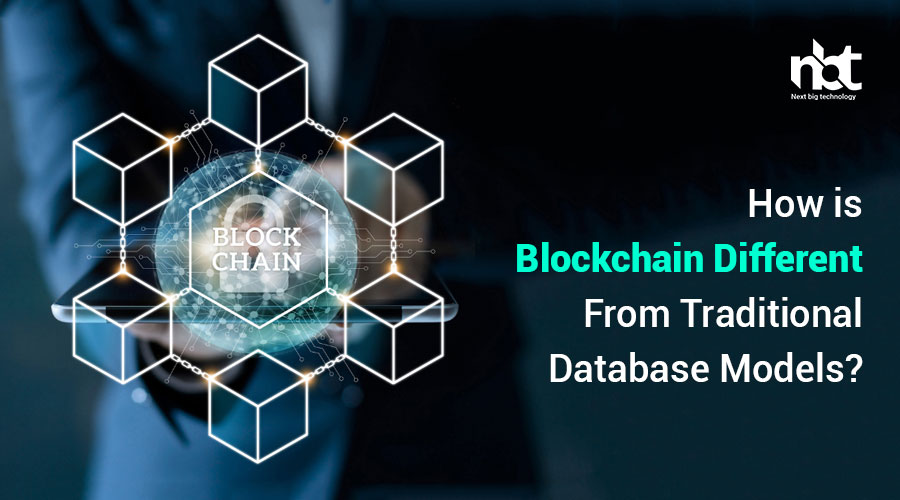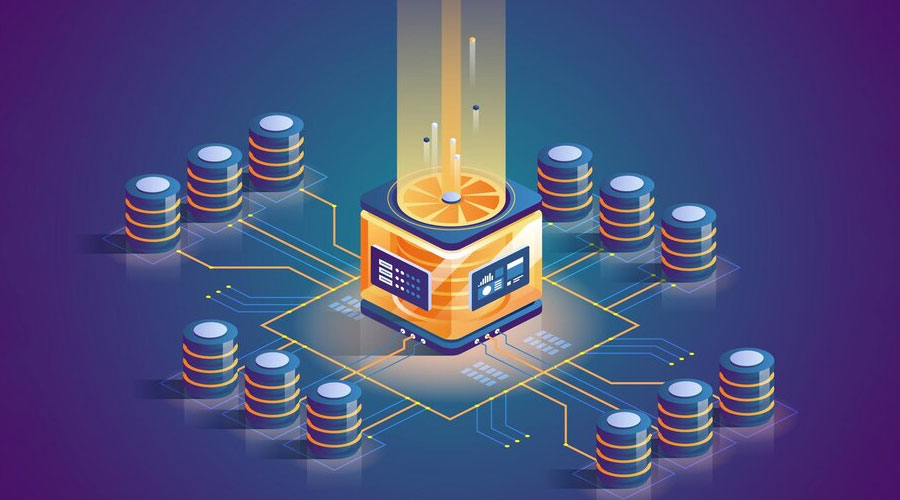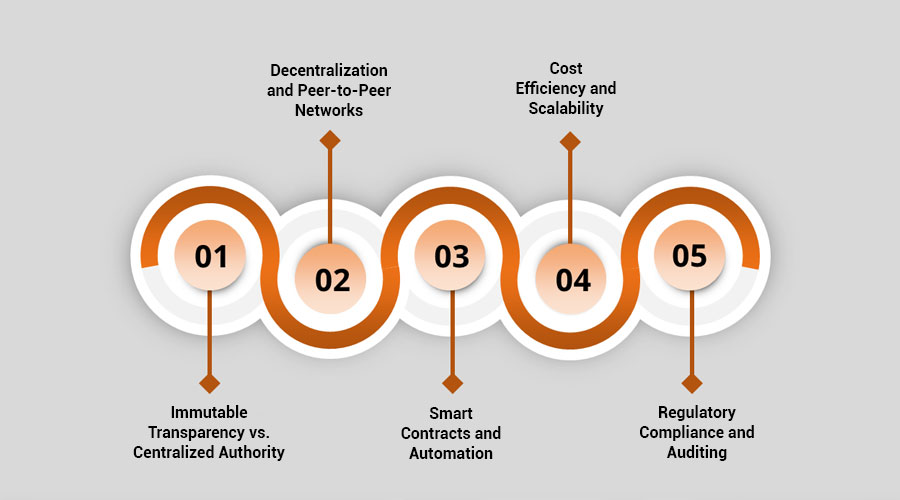Table of Contents
Understanding Blockchain and Traditional Databases
In today’s digital age, data reigns supreme, serving as the backbone of countless industries, from finance to healthcare and beyond. As the demand for secure, efficient, and transparent data management grows, two prominent technologies have emerged: blockchain and traditional databases. Understanding the distinctions between these two systems is crucial for businesses and individuals navigating the complex landscape of data management. Let’s delve into the intricacies of blockchain and traditional databases to shed light on their unique features and functionalities.
The Fundamentals:
At its core, a traditional database is a centralized system that stores and manages data in a structured format. It relies on a client-server architecture, where a central authority maintains control over the database and grants access to authorized users. Examples of traditional databases include SQL (Structured Query Language) databases like MySQL, Oracle, and PostgreSQL, which have long been the standard for storing and retrieving structured data.
On the other hand, blockchain represents a paradigm shift in data management. It is a decentralized, distributed ledger technology that operates on a peer-to-peer network. Unlike traditional databases, blockchain does not have a central authority. Instead, it relies on consensus mechanisms, such as Proof of Work (PoW) or Proof of Stake (PoS), to validate and record transactions across multiple nodes. Each block in the blockchain contains a cryptographic hash of the previous block, creating an immutable and tamper-resistant record of transactions.
Key Differences:
- Centralization vs. Decentralization: Traditional databases are centralized, meaning that a single entity or authority controls the database and its operations. In contrast, blockchain is decentralized, with no central authority controlling the network. This decentralization enhances security, as there is no single point of failure or vulnerability.
- Data Structure: Traditional databases store data in tables with predefined schemas, making them suitable for structured data storage and retrieval. In contrast, blockchain uses a distributed ledger structure, where data is stored in blocks linked together in a chronological chain. This structure enables transparency and auditability, as every transaction is recorded and timestamped.
- Security and Immutability: Blockchain’s distributed nature and cryptographic hashing make it inherently secure and immutable. Once a transaction is recorded on the blockchain, it cannot be altered or deleted without consensus from the network participants. This feature is particularly valuable in industries like finance and supply chain, where data integrity is paramount.
- Transaction Speed and Scalability: Traditional databases typically offer higher transaction throughput and scalability compared to blockchain. However, blockchain technology is continuously evolving to improve scalability through techniques like sharding and layer-2 solutions.
Applications and Use Cases:
Both blockchain and traditional databases have their respective strengths and weaknesses, making them suitable for different use cases:
- Traditional Databases: Well-suited for applications that require high throughput, low latency, and centralized control, such as banking systems, e-commerce platforms, and customer relationship management (CRM) software.
- Blockchain: Ideal for applications that prioritize decentralization, transparency, and immutability, such as cryptocurrency transactions, supply chain management, voting systems, and digital identity verification.
Comparing the Architecture of Blockchain and Traditional Databases
In the realm of digital innovation, two titans stand at the forefront: blockchain and traditional databases. While both serve as pillars of data management, their architectures diverge significantly, offering unique sets of advantages and limitations. Let’s embark on a journey to dissect and compare the architectures of blockchain and traditional databases, unraveling the intricacies that define their functionalities.
Blockchain: Decentralized Ledger Architecture
Blockchain, the revolutionary technology underpinning cryptocurrencies like Bitcoin and Ethereum, boasts a decentralized ledger architecture. At its core, a blockchain is a distributed database that stores transactional records, or “blocks,” in a chronological chain. Each block contains a cryptographic hash of the previous block, ensuring immutability and tamper resistance.
The decentralized nature of blockchain architecture eliminates the need for a central authority, allowing for peer-to-peer transactions and data storage. Nodes within the network validate and record transactions through a consensus mechanism, such as Proof of Work (PoW) or Proof of Stake (PoS), fostering transparency and security.
One of the key features of blockchain architecture is its transparency, as each participant in the network can view the entire transaction history. Moreover, the decentralized consensus mechanism mitigates the risk of a single point of failure, enhancing fault tolerance and resilience.
However, blockchain architecture comes with its own set of challenges, including scalability issues and high computational costs associated with consensus mechanisms like PoW. Additionally, the immutability of blockchain data poses challenges in scenarios where data modification or deletion is necessary.
Traditional Databases: Centralized Structure
In contrast to blockchain, traditional databases follow a centralized architecture, where data is stored in a single location under the control of a central authority. This architecture is characterized by relational database management systems (RDBMS) like MySQL, Oracle, and SQL Server.
Centralized databases excel in handling structured data, offering robust querying capabilities and transaction management features. They are widely adopted in various industries for their efficiency in handling large volumes of data and supporting complex transactions.
The centralized nature of traditional databases simplifies data management and ensures consistency, making them suitable for applications where data integrity is paramount. Additionally, traditional databases offer flexible schema designs, allowing for easy modification and optimization based on specific requirements.
However, traditional database architecture is susceptible to single points of failure, as the entire system relies on a central server. Security concerns also arise due to the centralized control of data, making traditional databases vulnerable to unauthorized access and data breaches.
Comparative Analysis
When comparing the architectures of blockchain and traditional databases, several factors come into play. Blockchain architecture prioritizes decentralization, immutability, and transparency, making it ideal for applications requiring trustless transactions and data integrity. On the other hand, traditional databases excel in performance, scalability, and flexibility, catering to a wide range of use cases in centralized environments.
Contrasting Methods in Blockchain and Traditional Databases
In the realm of digital innovation, two titans stand at the forefront: blockchain and traditional databases. While both serve as pillars of data management, their architectures diverge significantly, offering unique sets of advantages and limitations. Let’s embark on a journey to dissect and compare the architectures of blockchain and traditional databases, unraveling the intricacies that define their functionalities.
Blockchain: Decentralized Ledger Architecture
Blockchain, the revolutionary technology underpinning cryptocurrencies like Bitcoin and Ethereum, boasts a decentralized ledger architecture. At its core, a blockchain is a distributed database that stores transactional records, or “blocks,” in a chronological chain. Each block contains a cryptographic hash of the previous block, ensuring immutability and tamper resistance.
The decentralized nature of blockchain architecture eliminates the need for a central authority, allowing for peer-to-peer transactions and data storage. Nodes within the network validate and record transactions through a consensus mechanism, such as Proof of Work (PoW) or Proof of Stake (PoS), fostering transparency and security.
One of the key features of blockchain architecture is its transparency, as each participant in the network can view the entire transaction history. Moreover, the decentralized consensus mechanism mitigates the risk of a single point of failure, enhancing fault tolerance and resilience.
However, blockchain architecture comes with its own set of challenges, including scalability issues and high computational costs associated with consensus mechanisms like PoW. Additionally, the immutability of blockchain data poses challenges in scenarios where data modification or deletion is necessary.
Traditional Databases: Centralized Structure
In contrast to blockchain, traditional databases follow a centralized architecture, where data is stored in a single location under the control of a central authority. This architecture is characterized by relational database management systems (RDBMS) like MySQL, Oracle, and SQL Server.
Centralized databases excel in handling structured data, offering robust querying capabilities and transaction management features. They are widely adopted in various industries for their efficiency in handling large volumes of data and supporting complex transactions.
The centralized nature of traditional databases simplifies data management and ensures consistency, making them suitable for applications where data integrity is paramount. Additionally, traditional databases offer flexible schema designs, allowing for easy modification and optimization based on specific requirements.
However, traditional database architecture is susceptible to single points of failure, as the entire system relies on a central server. Security concerns also arise due to the centralized control of data, making traditional databases vulnerable to unauthorized access and data breaches.
Comparative Analysis
When comparing the architectures of blockchain and traditional databases, several factors come into play. Blockchain architecture prioritizes decentralization, immutability, and transparency, making it ideal for applications requiring trustless transactions and data integrity. On the other hand, traditional databases excel in performance, scalability, and flexibility, catering to a wide range of use cases in centralized environments.
Unique Consensus Protocols in Blockchain vs. Traditional Databases
In the realm of data management, the choice of consensus protocol plays a pivotal role in ensuring the integrity and security of stored information. While traditional databases have long relied on centralized authority for consensus, the emergence of blockchain technology has introduced innovative decentralized protocols. Let’s delve into the distinctive consensus protocols employed by blockchain and traditional databases, exploring their strengths and weaknesses.
Traditional Databases: Centralized Consensus
Traditional databases predominantly employ centralized consensus mechanisms, where a single entity or a consortium of trusted parties maintains control over data validation and verification. In this model, decisions regarding data integrity and validity are centralized, often resting in the hands of a designated authority. Common consensus methods in traditional databases include Byzantine Fault Tolerance (BFT), Practical Byzantine Fault Tolerance (PBFT), and Raft.
Strengths:
- Efficiency: Centralized consensus protocols typically offer faster transaction processing speeds due to the streamlined decision-making process.
- Control: Centralized authorities have full control over data management, making it easier to enforce compliance and security measures.
- Scalability: Traditional databases can scale more easily by adding more powerful hardware or optimizing software configurations.
Weaknesses:
- Single Point of Failure: The centralized nature of traditional databases poses a significant risk of a single point of failure, where a breach or malfunction can compromise the entire system.
- Vulnerability to Manipulation: Since consensus is controlled by a centralized authority, there’s a risk of data manipulation or censorship.
- Lack of Transparency: Participants have limited visibility into the consensus process, leading to potential distrust and reliance on intermediaries.
Blockchain: Decentralized Consensus
Blockchain technology revolutionized data management by introducing decentralized consensus protocols, eliminating the need for intermediaries and providing transparency and immutability. Consensus mechanisms such as Proof of Work (PoW), Proof of Stake (PoS), and Delegated Proof of Stake (DPoS) are integral to blockchain networks, ensuring agreement among network participants.
Strengths:
- Decentralization: Blockchain consensus protocols distribute decision-making power among network participants, reducing the risk of a single point of failure and enhancing resilience.
- Transparency: All transactions on the blockchain are transparent and immutable, providing a verifiable record of events without reliance on trust.
- Security: Cryptographic techniques and consensus algorithms in blockchain protocols make it exceedingly difficult for malicious actors to tamper with the data.
Weaknesses:
- Scalability Concerns: Some blockchain consensus mechanisms face challenges with scalability, particularly evident in networks like Bitcoin and Ethereum, where transaction throughput is limited.
- Energy Consumption: Proof of Work consensus, in particular, requires substantial computational power, leading to concerns about energy consumption and environmental impact.
- Governance Challenges: Decentralized consensus can lead to governance challenges, including decision-making deadlock and conflicts of interest among network participants.
Immutability and Auditability: Key Features Exclusive to Blockchain
In the ever-evolving landscape of technology, blockchain stands as a beacon of innovation, offering unique features that revolutionize various industries. Among its arsenal of capabilities, immutability and auditability shine as key pillars, setting blockchain apart from traditional databases. Let’s delve into these distinctive features and understand why they are exclusive to blockchain.
Immutability, the cornerstone of blockchain technology, refers to the inability to alter or tamper with data once it’s been recorded on the blockchain network. Unlike centralized databases where administrators hold the power to modify or delete information, blockchain’s distributed ledger ensures that once a transaction is validated and added to the chain, it becomes immutable. This immutable nature is achieved through cryptographic hash functions and consensus mechanisms, making it virtually impossible for any single entity to manipulate the data retroactively.
This immutability fosters trust and transparency within the blockchain ecosystem. Participants can have confidence in the integrity of transactions, knowing that they are permanent and incorruptible. Whether it’s financial transactions, supply chain records, or digital identities, the immutability of blockchain ensures a verifiable and tamper-proof record of events, eliminating the need for intermediaries and reducing the risk of fraud or data manipulation.
Auditability complements immutability by providing a transparent and traceable trail of transactions on the blockchain. Every action on the network is recorded in a chronological order, forming an immutable audit trail that can be accessed and verified by authorized parties. This transparency not only enhances accountability but also streamlines auditing processes across various sectors.
In finance, blockchain’s auditability revolutionizes the auditing and reconciliation of financial transactions, offering real-time visibility into the movement of assets and ensuring compliance with regulatory requirements. In supply chain management, it enables stakeholders to track the journey of products from the point of origin to the end consumer, enhancing transparency and trust among participants.
Moreover, the auditability of blockchain extends beyond financial and supply chain applications to areas such as healthcare, voting systems, and intellectual property rights. By providing an immutable and transparent record of data, blockchain empowers individuals and organizations to verify the authenticity and provenance of information, mitigating the risk of counterfeit products, electoral fraud, and intellectual property disputes.
However, while immutability and auditability are powerful features exclusive to blockchain, they also present challenges in terms of privacy and scalability. The transparent nature of blockchain raises concerns about the exposure of sensitive information, prompting the need for privacy-enhancing technologies such as zero-knowledge proofs and encryption techniques. Additionally, as blockchain networks scale to accommodate a larger volume of transactions, maintaining immutability and auditability without compromising performance remains a significant hurdle.
Addressing Scaling Issues in Blockchain and Traditional Databases
In the digital age, where data is king, the ability to scale databases efficiently is paramount. Whether it’s a blockchain or a traditional database, the challenges of scaling are ever-present. However, each presents its own unique set of hurdles and solutions. Let’s delve into how these two technologies address scaling issues and the strategies they employ.
Understanding the Scaling Challenge
Scaling refers to the capability of a system to handle increased workload or growing demands. In the realm of databases, scaling becomes particularly complex due to the need to maintain consistency, availability, and partition tolerance—the three pillars of the CAP theorem.
Scaling in Traditional Databases
Traditional databases, such as SQL databases, have long been the backbone of data storage and management systems. They rely on a centralized architecture where data is stored and managed in a single location. Scaling such databases often involves vertical scaling, where more resources are added to a single server to handle increased demand.
However, vertical scaling has its limitations. It can become prohibitively expensive and is not infinitely scalable. To address this, horizontal scaling comes into play. This involves distributing the database across multiple servers, also known as sharding or partitioning. While horizontal scaling offers better scalability, it introduces complexities related to data consistency and management across shards.
Addressing Scaling Challenges in Traditional Databases:
- Replication: Replicating data across multiple servers ensures redundancy and fault tolerance. However, maintaining consistency among replicas can be challenging, especially in distributed environments.
- Partitioning: Dividing the database into smaller partitions allows for parallel processing and improved performance. However, managing data distribution and ensuring balanced loads across partitions require careful planning.
- Caching: Implementing caching mechanisms can alleviate the load on the database by storing frequently accessed data closer to the user. This reduces latency and improves overall system performance.
Scaling in Blockchain
Blockchain technology, while relatively new compared to traditional databases, introduces innovative solutions to scaling challenges. Blockchain operates on a decentralized network where data is stored across multiple nodes, ensuring transparency, immutability, and security.
Addressing Scaling Challenges in Blockchain:
- Consensus Mechanisms: Blockchain employs consensus mechanisms like Proof of Work (PoW) or Proof of Stake (PoS) to validate and append new transactions to the ledger. However, these mechanisms can be resource-intensive and limit transaction throughput.
- Sharding: Similar to traditional databases, blockchain networks can implement sharding to divide the network into smaller partitions, or shards, each processing a subset of transactions. Sharding improves scalability by parallelizing transaction processing.
- Layer 2 Solutions: Off-chain scaling solutions, such as payment channels and sidechains, enable transactions to be conducted off the main blockchain, reducing congestion and speeding up transaction times while maintaining security.
Governance Models in Blockchain and Traditional Databases
In the realm of digital innovation, the governance models adopted by technological infrastructures play a pivotal role in shaping their functionality, security, and transparency. This is particularly evident in the comparison between blockchain and traditional databases. While both serve as repositories of valuable information, their underlying governance mechanisms diverge significantly, each presenting unique advantages and challenges. Let’s delve into the intricacies of governance models in blockchain and traditional databases to unveil their distinct features and implications.
Blockchain Governance: Decentralized Autonomy
Blockchain technology introduces a paradigm shift in governance by promoting decentralized autonomy. Governed by consensus algorithms, such as Proof of Work (PoW) or Proof of Stake (PoS), blockchain networks empower participants to collectively validate and record transactions without the need for a central authority. This distributed governance model ensures transparency, immutability, and resilience, mitigating the risk of single points of failure and unauthorized alterations.
Moreover, blockchain governance often involves mechanisms for protocol upgrades and decision-making through on-chain governance systems. Participants can propose and vote on network improvements or modifications, fostering a democratic and inclusive environment. However, achieving consensus among diverse stakeholders can be challenging, leading to potential forks and divergent community interests.
Furthermore, smart contracts, self-executing agreements coded on the blockchain, enforce predefined rules and conditions autonomously. This enhances trust and eliminates the need for intermediaries, revolutionizing various sectors, including finance, supply chain management, and decentralized applications (DApps).
Traditional Database Governance: Centralized Authority
In contrast, traditional databases rely on centralized governance structures, where a designated authority exercises control over data management, access permissions, and system updates. Typically, database administrators oversee operations, ensuring data integrity, security, and compliance with regulatory standards. While this model offers efficiency and centralized control, it poses inherent vulnerabilities, including the risk of unauthorized access, data manipulation, and system failures.
Moreover, traditional databases lack the transparency and immutability inherent in blockchain systems. Changes to data records are susceptible to manipulation, requiring trust in the integrity of centralized entities. Additionally, the dependency on intermediaries for transaction validation and settlement introduces delays, costs, and potential points of failure.
Comparative Analysis: Advantages and Challenges
In evaluating the governance models of blockchain and traditional databases, several key considerations emerge:
- Security and Immutability: Blockchain’s decentralized architecture enhances security and immutability by distributing data across a network of nodes, making it resistant to tampering and unauthorized alterations. Traditional databases, on the other hand, rely on centralized entities for data management, posing security risks and trust dependencies.
- Transparency and Trust: Blockchain’s transparent ledger enables stakeholders to trace the entire transaction history, fostering trust and accountability. In contrast, traditional databases lack inherent transparency, requiring reliance on centralized authorities for data verification and validation.
- Scalability and Efficiency: Traditional databases often exhibit superior scalability and efficiency in processing large volumes of transactions compared to blockchain networks, which may encounter scalability challenges due to consensus mechanisms and network congestion.
- Regulatory Compliance: While traditional databases adhere to established regulatory frameworks, blockchain’s decentralized nature raises concerns regarding compliance, especially in highly regulated industries where data privacy and governance standards are paramount.
Ensuring Data Integrity in Blockchain vs. Traditional Databases
In today’s data-driven world, ensuring the integrity and security of information is paramount. As technology advances, so do the methods for safeguarding data. Two prominent contenders in this arena are blockchain and traditional databases. Both offer unique approaches to maintaining data integrity, but they differ significantly in their underlying mechanisms and effectiveness. Let’s delve into a comparative analysis to understand how each tackles this critical aspect of data management.
Blockchain, the underlying technology behind cryptocurrencies like Bitcoin, has gained widespread attention for its immutable and decentralized nature. At its core, a blockchain is a distributed ledger that records transactions across a network of computers in a tamper-proof and transparent manner. Each block in the chain contains a cryptographic hash of the previous block, creating a chronological and immutable record of transactions. This cryptographic linkage ensures that any attempt to alter a single block would necessitate altering all subsequent blocks, making it nearly impossible to tamper with the data without detection.
One of the key features of blockchain is its decentralized architecture. Unlike traditional databases that rely on a central authority for validation and maintenance, blockchain operates on a peer-to-peer network where every participant maintains a copy of the entire ledger. This decentralization eliminates single points of failure and significantly reduces the risk of data manipulation or unauthorized access. Furthermore, consensus mechanisms such as Proof of Work (PoW) or Proof of Stake (PoS) ensure that all transactions are validated by the network before being added to the blockchain, further enhancing security and integrity.
On the other hand, traditional databases, while widely used and familiar, lack the inherent security measures offered by blockchain. Centralized databases are susceptible to various vulnerabilities, including data breaches, insider threats, and unauthorized modifications. While measures such as encryption, access controls, and regular backups can mitigate some risks, they do not guarantee the same level of immutability and transparency as blockchain.
Moreover, traditional databases are prone to single points of failure, as they rely on a centralized authority for validation and maintenance. A breach or compromise of this central authority could result in widespread data corruption or loss, undermining the integrity of the entire database.
In summary, while both blockchain and traditional databases play crucial roles in data management, their approaches to ensuring integrity differ significantly. Blockchain’s decentralized and immutable nature, coupled with cryptographic security measures, provides a robust solution for safeguarding data against tampering and unauthorized access. Traditional databases, while widely used, lack the same level of security and transparency, making them more susceptible to various threats.
Real-World Applications Highlighting Differences Between Blockchain and Traditional Databases
In the realm of digital innovation, two significant technologies have been at the forefront of discussion: blockchain and traditional databases. Both serve as pillars of data management, yet their underlying structures and applications diverge significantly. Let’s embark on a journey through real-world scenarios to unravel the disparities between blockchain and traditional databases.
- Immutable Transparency vs. Centralized Authority: Blockchain, as epitomized by Bitcoin, champions immutable transparency. In the realm of finance, blockchain ensures that every transaction is recorded in a secure, tamper-proof ledger accessible to all participants. Conversely, traditional databases rely on a centralized authority, where data management and access are governed by a single entity. This fundamental difference is pivotal in scenarios where trust and transparency are paramount, such as supply chain management and voting systems.
- Decentralization and Peer-to-Peer Networks: Blockchain’s decentralized nature fosters a peer-to-peer network where data is distributed across multiple nodes, ensuring resilience against single points of failure. This architecture finds application in industries like healthcare, where patient records need to be securely shared among various stakeholders without compromising privacy. In contrast, traditional databases operate on a client-server model, where a central server stores and manages data. While efficient for certain applications, this model is susceptible to downtimes and security breaches.
- Smart Contracts and Automation: Ethereum, a prominent blockchain platform, introduced the concept of smart contracts, self-executing contracts with the terms of the agreement directly written into code. These smart contracts automate processes, eliminating the need for intermediaries and reducing the risk of errors or disputes. Real estate, for instance, can leverage smart contracts to streamline property transactions, ensuring transparency and reducing processing times. Traditional databases lack this inherent capability for automation, requiring manual intervention at various stages of a transaction.
- Cost Efficiency and Scalability: Traditional databases often entail significant infrastructure and maintenance costs, particularly as data volumes grow. Scalability can become a challenge, requiring extensive investments in hardware and software upgrades. Blockchain, on the other hand, offers a cost-efficient model by eliminating intermediaries and reducing the overhead associated with centralized systems. This scalability is exemplified in the domain of digital asset management, where blockchain enables fractional ownership and seamless transfer of assets with minimal transaction fees.
- Regulatory Compliance and Auditing: Regulatory compliance and auditing are critical considerations across industries, particularly in finance and healthcare. Blockchain’s immutable ledger provides a transparent audit trail, facilitating compliance with regulatory standards and enabling efficient auditing processes. Traditional databases, while capable of implementing compliance measures, often lack the inherent transparency and tamper-proof features of blockchain, leading to challenges in ensuring data integrity and regulatory adherence.
Top Blockchain Different From Traditional Database Development Companies
In the realm of modern technology, two distinct yet interconnected systems hold significant sway: blockchain and traditional databases. While both serve as pillars of data management, they operate on fundamentally different principles, each catering to unique needs and purposes. In this article, we delve into the nuances that set apart the top blockchain development companies from their traditional database counterparts.
-
Next Big Technology:

Focus Area
- Mobile App Development
- App Designing (UI/UX)
- Software Development
- Web Development
- AR & VR Development
- Big Data & BI
- Cloud Computing Services
- DevOps
- E-commerce Development
Industries Focus
- Art, Entertainment & Music
- Business Services
- Consumer Products
- Designing
- Education
- Financial & Payments
- Gaming
- Government
- Healthcare & Medical
- Hospitality
- Information Technology
- Legal & Compliance
- Manufacturing
- Media
2. Security and Immutability: Blockchain’s greatest strength lies in its security features. Through cryptographic techniques, each block in the chain is linked to the previous one, making it nearly impossible to alter past transactions without consensus from the network participants. This immutability ensures data integrity and mitigates the risk of fraud or tampering.
Traditional databases, while secure in their own right, are more susceptible to hacking and unauthorized access due to their centralized nature. Without the robust cryptographic protocols of blockchain, securing data in traditional databases often requires additional layers of security measures.
3. Transparency and Trust: Blockchain’s transparent nature enables all network participants to view the entire transaction history, fostering trust and accountability. This level of transparency is particularly beneficial in industries like finance, supply chain, and healthcare, where stakeholders require visibility into transactional data.
Traditional databases, while capable of providing transparency to a certain extent, often lack the inherent trustworthiness of blockchain. Auditing and verifying data in traditional databases can be cumbersome and prone to errors, especially in complex systems with multiple points of entry.
4. Use Cases and Applications: Blockchain technology finds applications across various industries, including finance, healthcare, supply chain management, and voting systems. Smart contracts, decentralized finance (DeFi), and non-fungible tokens (NFTs) are just a few examples of innovative solutions enabled by blockchain development companies.
Traditional databases, on the other hand, remain indispensable for businesses requiring efficient data storage and retrieval. Industries such as e-commerce, customer relationship management (CRM), and human resources rely heavily on traditional database systems to manage large volumes of structured data.
5. Evolution and Adoption: Blockchain technology is still in its nascent stages, continually evolving to address scalability, interoperability, and regulatory challenges. Despite its potential, widespread adoption of blockchain solutions faces hurdles such as scalability issues and regulatory uncertainty.
Traditional databases, on the contrary, have been around for decades and have undergone significant refinement and optimization. While blockchain offers disruptive potential, traditional databases remain the backbone of many established industries and enterprises.
FAQs On Blockchain Different From Traditional Database Development
In the rapidly evolving landscape of technology, few innovations have captured the imagination quite like blockchain. From cryptocurrencies to supply chain management, its applications seem boundless. Yet, for many, understanding how blockchain differs from traditional database development remains a puzzle. Fear not, for we’re here to shed light on this enigma through some frequently asked questions.
1. What sets blockchain apart from traditional databases?
- Traditional databases, like SQL databases, are centralized, meaning they rely on a single entity to control and manage the data. In contrast, blockchain operates in a decentralized manner, where data is distributed across a network of computers (nodes), eliminating the need for a central authority.
2. How does blockchain ensure security?
- Security in blockchain stems from its decentralized nature and cryptographic principles. Each block contains a cryptographic hash of the previous block, creating a chain that is immutable. Moreover, consensus mechanisms like Proof of Work or Proof of Stake ensure that transactions are verified by the network, making it extremely difficult for malicious actors to alter data.
3. Can blockchain handle the same volume of transactions as traditional databases?
- Currently, blockchain networks have limitations in terms of scalability and transaction throughput compared to traditional databases. While advancements like sharding and layer 2 solutions are being developed to address these issues, blockchain is still not as efficient for high-frequency transactional data as traditional databases.
4. How does blockchain ensure data integrity?
- In a blockchain, each transaction is time-stamped, cryptographically signed, and linked to the previous transaction, forming an unbroken chain of data. Any attempt to alter a past transaction would require changing all subsequent blocks, which is computationally infeasible due to the distributed nature of the network and the consensus mechanisms in place.
5. What are the implications of blockchain’s transparency and immutability?
- Transparency and immutability are double-edged swords. While they enhance trust and accountability by allowing anyone to verify transactions on the blockchain, they also raise privacy concerns, especially in contexts where certain data should be kept confidential. Balancing transparency with privacy is a key consideration in blockchain application development.
6. Are smart contracts exclusive to blockchain?
- Smart contracts, self-executing contracts with the terms of the agreement directly written into code, are indeed synonymous with blockchain, particularly with platforms like Ethereum. While traditional databases can execute logic through stored procedures or triggers, smart contracts offer a higher degree of transparency, security, and automation.
7. Is blockchain suitable for all types of applications?
- Not necessarily. While blockchain offers unique advantages in terms of decentralization, security, and transparency, it may not be the best solution for every use case. Applications that require high throughput, low latency, or centralized control may be better served by traditional databases. It’s crucial to assess the specific needs of the application before deciding on the technology stack.
Thanks for reading our post “How is Blockchain Different From Traditional Database Models?”. Please connect with us to learn more about Best Blockchain Different From Traditional Database Models.






















